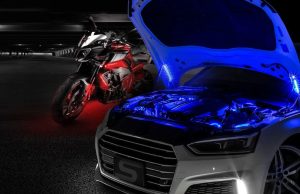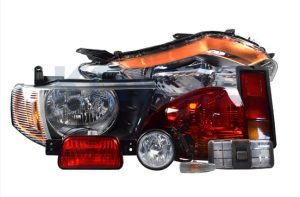Lighting plays a critical role in vehicle safety, visibility, and style. Whether it’s a motorcycle weaving through traffic or a car cruising at night, lighting ensures both driver and pedestrian awareness. While the fundamentals of lighting remain similar across vehicles, motorcycles and cars differ significantly in design, application, and regulation. However, they also share many emerging technologies.
This article explores the key differences and shared lighting technologies between motorcycles and cars, highlighting practical and regulatory considerations.
Lighting Basics: The Purpose for Both

Lighting in both motorcycles and cars serves four core purposes:
-
Visibility: Making the vehicle visible to others.
-
Illumination: Lighting the road ahead.
-
Communication: Signaling braking, turning, or reversing.
-
Aesthetics: Enhancing the look of the vehicle.
Key Differences Between Motorcycle and Car Lighting
Motorcycles are smaller, more agile, and more vulnerable in traffic, influencing their lighting system design.
Table: Main Lighting Differences
| Feature | Motorcycles | Cars |
|---|---|---|
| Headlight Configuration | Usually single or dual small beams | Dual, often large headlights |
| Tail/Brake Lights | Compact units integrated into rear fender | Separate tail and brake light housings |
| Turn Signals | Often smaller and mounted externally | Larger and embedded in body panels |
| Running Lights | Mandatory in many regions | Usually integrated into headlight clusters |
| Lighting Area Coverage | Narrower spread | Wider road coverage |
| Load on Battery | Low power usage | Higher due to more lighting elements |
Design Constraints and Impacts
Space and Placement
-
Motorcycles have minimal surface area, so lighting must be compact and multifunctional.
-
Cars benefit from larger front and rear ends, allowing separation of lights for function and style.
Power Consumption
-
Motorcycles have smaller batteries and charging systems, making LED technology crucial for efficiency.
-
Cars can support more energy-intensive lighting like adaptive headlights or ambient interior lighting.
Visibility & Safety
-
Due to their narrow profile, motorcycles rely more on daytime running lights (DRLs) and reflective surfaces for visibility.
-
Cars already occupy more visual space but benefit from features like cornering lights or adaptive high beams.
Shared Lighting Technologies
Despite differences, both motorcycles and cars are adopting modern lighting tech for safety, efficiency, and aesthetics.
Shared Technologies Table
| Technology | Motorcycle Use | Car Use |
|---|---|---|
| LED Lighting | Common for headlights, signals | Standard in new models |
| Projector Headlights | Found in premium or touring bikes | Used for focused beam pattern |
| Adaptive Lighting | Rare, but present in high-end bikes | Widely used in premium vehicles |
| Daytime Running Lights (DRLs) | Increasingly mandatory | Common and often automatic |
| Smart Brake Lighting | Used to warn following traffic | Advanced systems with variable intensity |
| Bluetooth/App-Controlled RGB | Popular in custom scenes | Available in aftermarket kits |
Regulatory Differences
Lighting rules vary by country but often differentiate between cars and motorcycles.
Common Regulatory Rules:
| Rule | Motorcycles | Cars |
|---|---|---|
| Headlight Color | White or yellow | White only (in many regions) |
| Tail Light Color | Red only | Red only |
| Turn Signal Color | Amber or red (US), amber (Europe) | Amber or red (US), amber (Europe) |
| DRL Requirements | Mandatory in EU, recommended in US | Mandatory in most new cars globally |
| Height Requirements for Lights | More lenient due to vehicle size | Strict height regulations |
Customization and Aftermarket Trends
Motorcycles often lean toward personalization, with lighting kits being popular in the custom bike community. However, customization must meet road safety rules.
Popular Modifications:
For Motorcycles:
-
LED strip accent lighting
-
Sequential turn signals
-
Halo rings on headlamps
-
Wheel lights for visibility
For Cars:
-
Ambient interior lighting
-
Adaptive LED headlight retrofits
-
Custom underglow or DRL upgrades
-
Matrix beam headlights
Note: Modifying lights may void warranties or violate traffic laws. Always check local regulations.
Cost & Maintenance Comparison
| Factor | Motorcycle Lighting | Car Lighting |
|---|---|---|
| Initial Cost | Lower overall | Higher due to complexity |
| Replacement Frequency | Less frequent with LED upgrades | More components, higher chance |
| Maintenance Complexity | Easier DIY fixes | Often requires professional help |
Safety Innovations: Future of Lighting
Emerging technologies are shaping how lighting contributes to safety:
-
Corner-Adaptive Lights: Already common in cars; some touring motorcycles include them.
-
Laser Headlights: Still rare; seen on luxury cars.
-
Vehicle-to-Vehicle (V2V) Light Communication: Under research for both.
-
AI Lighting Systems: Adjust brightness, direction, and color temperature in real-time based on traffic.
Practical Tips for Riders and Drivers
For Motorcyclists:
-
Use high-quality LED DRLs for better daytime visibility.
-
Install reflectors or spoke lights for nighttime safety.
-
Keep headlight lens clean and aimed correctly.
For Car Owners:
-
Upgrade to adaptive or projector headlamps for better road visibility.
-
Don’t overlook interior lighting — improves usability and comfort.
-
Replace worn or dim bulbs in pairs for consistency.
Where to Buy Reliable Lighting for Any Vehicle

Looking to upgrade your car or motorcycle lighting system?
Buy Car Lighting online
Browse a range of reliable, high-performance lighting solutions for vehicles of all types.
Conclusion
Motorcycles and cars may differ dramatically in size and design, but both rely heavily on lighting for safety and functionality. While motorcycles require compact, power-efficient lighting, cars benefit from more advanced, integrated systems. As technologies continue to converge, expect smarter, safer, and more personalized lighting experiences for both riders and drivers.
Whether you’re upgrading for safety, style, or both, knowing the differences and shared tech ensures better decisions — and better visibility on the road.